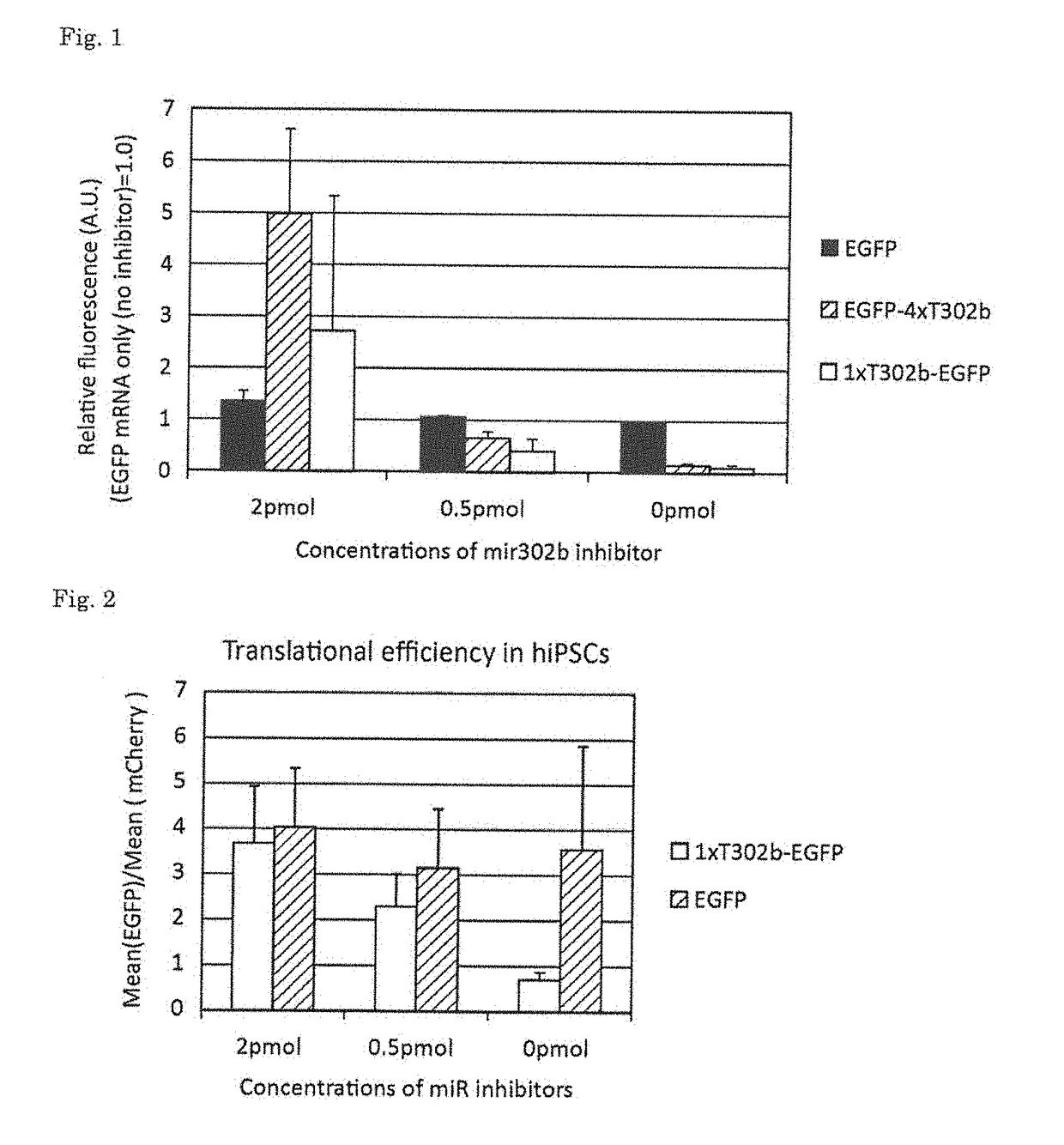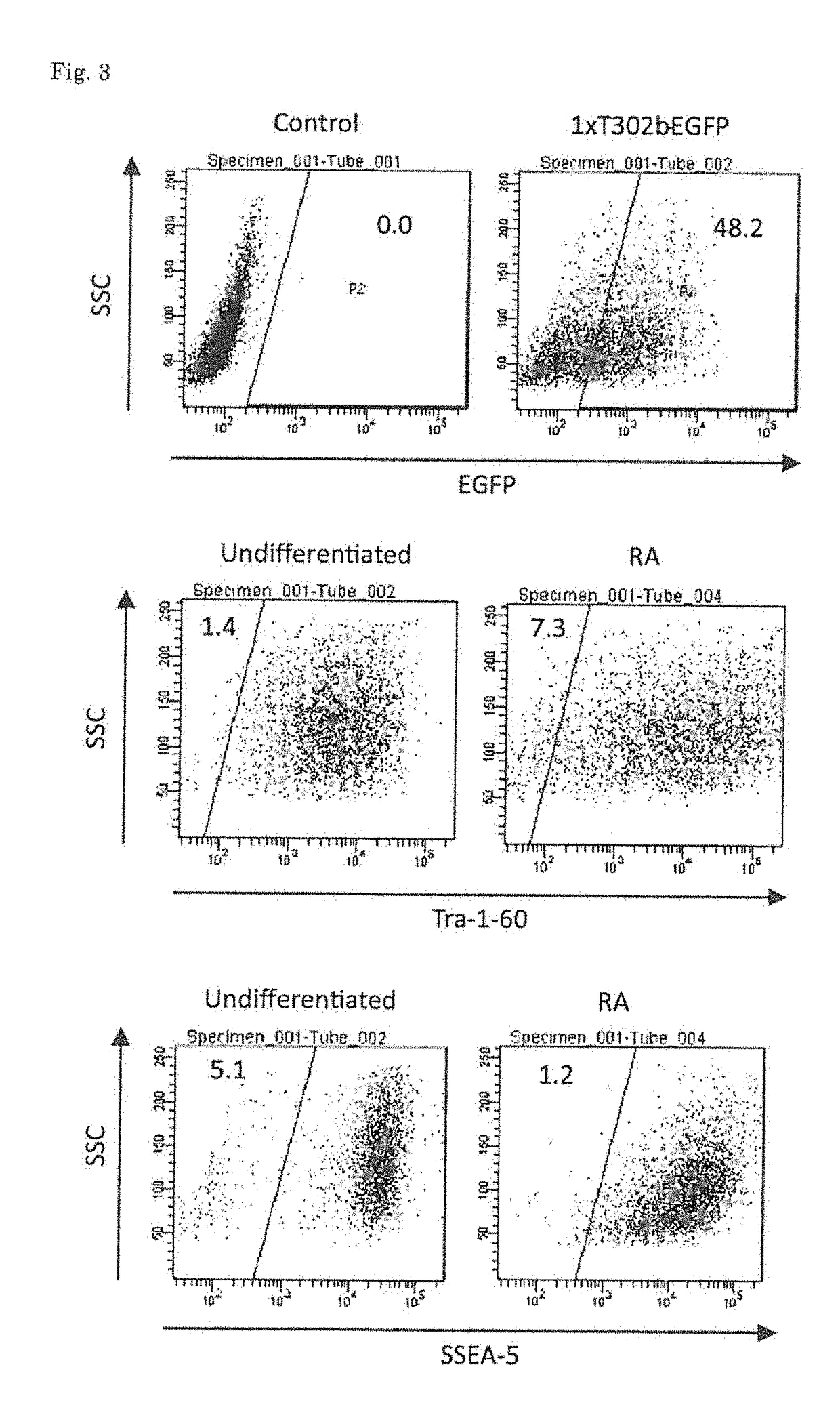Method for extracting differentiated cells
- Summary
- Abstract
- Description
- Claims
- Application Information
AI Technical Summary
Benefits of technology
Problems solved by technology
Method used
Image
Examples
example 1
[0051][Designing of miR-302b-Responsive Reporter mRNA]
[0052]EGFP mRNA (SEQ ID NO: 1), which encodes the fluorescence reporter gene EGFP and includes the five prime untranslated region. (5′ UTR) and the three prime untranslated region (3′ UTR) of α globin, was modified, and miR-302b-responsive reporter mRNA (1xT302b-EGFP) (SEQ ID NO: 2) comprising one copy of the target sequence of miR-302b in the 5′ UTR and miR-302b-responsive reporter mRNA (EGFP-4xT302b) (SEQ ID NO: 3) comprising 4 copies of the target sequence of miR-302b in the 3′ UTR were each designed. Moreover, mCherry mRNA (SEQ ID NO: 4) comprising the 51 UTR and 3′ UTR of α globin, which was used as a control, was also designed. These gene sequences are shown below.
Gene sequence of EGFP-mRNA(SEQ ID NO: 1)CGCCACCAUGGGAUCCGUGAGCAAGGGCGAGGAGCUGUUCACCGGGGUGGUGCCCAUCCUGGUCGAGCUGGACGGCGACGUAAACGGCCACAAGUUCAGCGUGUCCGGCGAGGGCGAGGGCGAUGCCAGCUACGGCAAGCUGACCCUGAAGUUCAUCUGCACCACCGGCAAGCUGCCCGUGCCCUGGCCCACCCUCGUGACCACCCUGACCUACGGCGUGCAGU...
example 2
[0072][Sorting of Differentiation-Induced Cells]
[0073]Human iPS cells were seeded on a Matrigel (BD)-coated 10 cm dish, and were then cultured in a retinoic acid medium (DMEM-F12 (Invitrogen) containing 0.5 uM retinoic acid (Sigma), 10% FBS (GIBCO), 0.5% Penicillin-streptomycin (Invitrogen), % Glutamax (Invitrogen), and 1% NEAA (Invitrogen)) for 3 days (Tang C, et al., Nature Biotechnology, 29(9): 829-34, 2011). After completion of the culture, the cells were separated from the culture dish, and were then seeded again on a Matrigel-coated 10 cm dish containing mTeSR1 medium (Stem cell technologies) or the same medium as described above. On the following day, 1xT302b-EGFP was transfected into the cells. The transfection was carried out using 24 μl of stemfect (Stemgent) in accordance with the manufacturer's instructions. Twenty-four hours after the transfection, the resulting cells were separated from the culture dish, and the fluorescence intensity of EGFP was then analyzed by flow ...
example 3
[0076][Designing of 302a-5p- and -367-3p-Responsive Reporter mRNAs]
[0077]hmAG1-mRNA (SEQ ID NO: 19), which encodes the fluorescence reporter gene hmAG1 and includes the five prime end untranslated region (5′ UTR) and the three prime end untranslated region (3′ UTR) of α globin, was modified, and miR-302a-5p-responsive reporter mRNA (SEQ ID NO: 20) comprising one copy of the target sequence of miR-302a-5p in the 5′ UTR and miR-367-3p-responsive reporter mRNA (SEQ ID NO: 21) comprising one copy of the target sequence of miR367-3p in the 5′ UTR were each designed. Moreover, in order to normalize transfection, tagBFP mRNA (SEQ ID NO: 22) comprising the 5′ UTR and 3′ UTR of α globin, which was to be used as a control, was also designed. Furthermore, as a drug resistance gene, Puromycin R-mRNA (SEQ ID NO: 23) comprising a puromycin resistance gene was modified, and 302a-5p-responsive Puromycin R-mRNA (SEQ ID NO: 24) comprising one copy of the target sequence of miR-302a-5p in the 5′ UTR w...
PUM
 Login to view more
Login to view more Abstract
Description
Claims
Application Information
 Login to view more
Login to view more - R&D Engineer
- R&D Manager
- IP Professional
- Industry Leading Data Capabilities
- Powerful AI technology
- Patent DNA Extraction
Browse by: Latest US Patents, China's latest patents, Technical Efficacy Thesaurus, Application Domain, Technology Topic.
© 2024 PatSnap. All rights reserved.Legal|Privacy policy|Modern Slavery Act Transparency Statement|Sitemap



